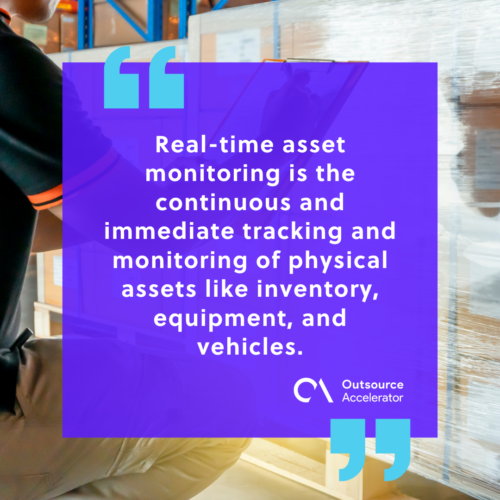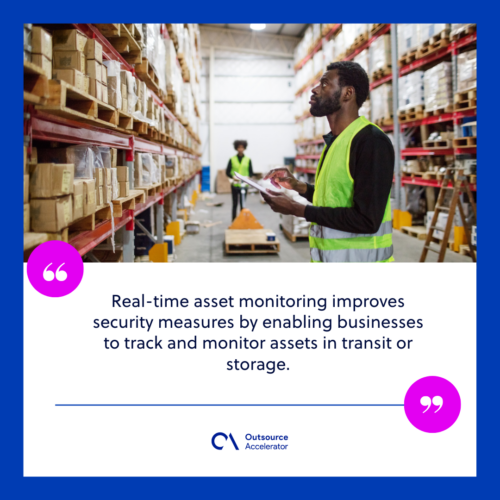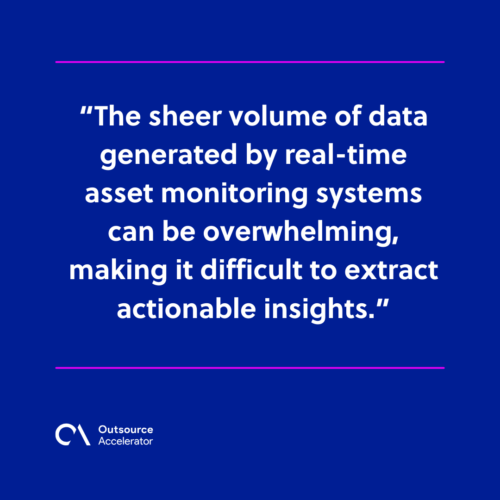The importance of real-time asset monitoring in supply chain management

To stay ahead of the curve, one must welcome innovation however it appears. In the world of supply chain operations, this means elevating precision and agility.
Imagine having the ability to track the exact location of every crucial asset in your supply chain in real time. You can foresee maintenance needs before they become costly disruptions and effortlessly navigate through bottlenecks with higher visibility and control.
With real-time asset monitoring, all your decisions are informed by data, and disruptions are anticipated before they occur.
This isn’t a distant future, but a present reality for forward-thinking businesses that understand this technology’s power.
In this article, we’ll look at why asset monitoring is critical, the benefits it brings, and how it’s reshaping the supply chain landscape as we know it.
What is real-time asset monitoring?
Real-time asset monitoring is the continuous and immediate tracking and monitoring of physical assets like inventory, equipment, and vehicles. The real-time aspect is enabled by technologies like sensors, GPS, RFID tags, and Internet of Things (IoT) devices.
These technologies provide instant updates on the assets’ status, location, and condition.
Real-time asset monitoring is an essential aspect of supply chain management. It improves efficiency, saves costs, and enhances visibility and control of assets and inventory.

5 Benefits of real-time asset monitoring in supply chain management
Real-time asset monitoring offers several benefits that can transform supply chain management.
Some of these advantages include:
1. Enhanced asset visibility
Real-time asset monitoring provides a clear, up-to-the-minute view of assets throughout the supply chain. This visibility allows businesses to monitor the movement of goods, ensuring they know exactly where each item is at any given time.
Businesses can optimize asset utilization, prevent loss or theft, and improve overall asset management processes.
2. Improved inventory management
Real-time asset monitoring gives accurate and up-to-date information on their inventory levels. By reducing the need for manual tracking, asset monitoring systems can eliminate bottlenecks and improve overall workflow.
Paired with asset management software, it leads to faster processing times and more efficient use of resources.
3. Proactive maintenance and reduced downtime
Monitoring the condition of assets in real time allows for predictive maintenance.
With real-time data on asset performance and health, issues can be identified and addressed before they become major problems. This extends the lifespan of assets and minimizes unexpected maintenance costs and disruptions in supply chain operations.
4. Better decision making
Access to real-time information enables more informed and timely decisions.
Businesses can react quickly to changes in demand, supply disruptions, and other dynamic factors. Improving overall agility and responsiveness.
5. Security and risk management
Real-time asset monitoring improves security measures by enabling businesses to track and monitor assets in transit or storage. With these tracking solutions, businesses can prevent theft, detect unauthorized access, and ensure compliance with security protocols.
Additionally, real-time monitoring helps mitigate risks associated with asset loss, damage, or delays, enhancing overall risk management practices.

Key technologies enabling real-time asset monitoring
Real-time asset monitoring in supply chain management relies on several key technologies to enable efficient tracking and management of assets throughout the supply chain.
Some of the key technologies enabling this asset monitoring include:
1. Internet of Things (IoT)
IoT involves a network of connected devices and sensors that collect and transmit data in real time.
IoT technologies play a vital role in real-time asset monitoring. They connect assets to the internet and enable communication between devices.
IoT sensors can be attached to assets to monitor their location, condition, and status.
2. GPS and RFID technology
GPS (Global Positioning System) provides precise location tracking for assets and is particularly useful for vehicles and shipments.
It allows businesses to track the movement and position of these assets, ensuring they’re on the correct route and schedule.
RFID (Radio-Frequency Identification) tags are automatically recognized and tracked by means of electromagnetic fields. It’s ideal for tracking inventory within warehouses and storage facilities.
3. Cloud computing
The cloud continues to be a place where new technology and software can grow.
Cloud-based platforms store and process the vast amounts of data collected by IoT devices, GPS, and RFID systems. Cloud computing ensures data is accessible from anywhere, enabling real-time updates and collaboration among stakeholders.
It also offers scalability, allowing businesses to handle increasing amounts of data as their operations grow.
4. Advanced analytics and artificial intelligence
AI and advanced analytics process the collected data to generate insights and predictions.
Predictive maintenance, for example, uses AI to analyze data from IoT sensors to foresee equipment failures before they happen. AI algorithms also help optimize routes, manage inventory levels, and make data-driven decisions.
5, Edge computing
Edge computing involves processing data closer to the source (e.g., on the IoT devices themselves) rather than sending it all to a central cloud server.
This reduces latency and ensures faster responses, which is crucial for real-time monitoring applications.
Challenges and considerations with real-time asset monitoring
While real-time asset monitoring offers numerous benefits, organizations may also encounter challenges when implementing and managing such systems.
Here are some common challenges of real-time asset monitoring and ways to overcome them:
Implementation costs
Challenge: The initial investment for setting up real-time asset monitoring systems can be significant. Ongoing maintenance and upgrades also add to the cost.
Solution: Start with a pilot project to demonstrate ROI and scale gradually. Seek out cost-effective solutions and negotiate with vendors for better pricing.
Additionally, consider leveraging cloud-based services to reduce infrastructure costs.
Data overload
Challenge: The sheer volume of data generated by real-time asset monitoring systems can be overwhelming, making it difficult to extract actionable insights.
Solution: Implement advanced analytics and AI tools to process and analyze data efficiently. Use data visualization techniques to present information in an easily understandable format. Focus on key performance indicators (KPIs) that align with business goals.

Network connectivity and reliability
Challenge: Real-time monitoring relies on consistent network connectivity. In remote or challenging environments, maintaining reliable connections can be difficult.
Solution: Use a combination of connectivity options such as cellular, satellite, and Wi-Fi to ensure redundancy. Implement edge computing to process data locally and reduce dependence on constant network availability.
Training and skill requirements
Challenge: Employees may require training to effectively use and manage new real-time monitoring systems. There may also be a skill gap in handling advanced technologies.
Solution: Invest in thorough training courses and give continuing assistance. Employ or educate staff members who possess the required technical skills. Encourage a culture of continuous learning and innovation.
Battery life and maintenance of IoT devices
Challenge: IoT devices and sensors require power to operate, and frequent battery replacements or maintenance can be cumbersome.
Solution: Use energy-efficient devices with long battery life. Explore energy-harvesting technologies that utilize ambient energy sources. Implement a maintenance schedule to ensure devices are functioning optimally.







 Independent
Independent




